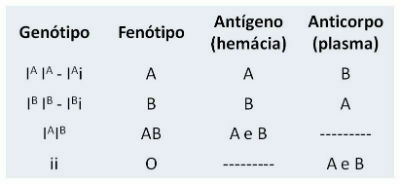You blood types were discovered in the early 20th century by the physician Karl Landsteiner.
He found that by mixing blood samples from different people, the red blood cells clumped together.
In 1902, he concluded that the incompatibility is due to the different types of blood that exist and the immunological reactions between them.
Landsteiner's discovery of blood types was a milestone in medical history and helped save many lives. Many people have died from blood transfusions due to incompatibility with donated blood.
The human species has different blood types. The most important are the ABO System and the Rh Factor.
ABO system
The genetic inheritance of blood groups in the human species is an example of multiple alleles or polyallelia.
At the ABO system there are three genes that will play a role in blood type formation. They are: ITHE IB Hey. Depending on the pattern of inheritance, the blood groups can be A, AB, B and O.
Gene alleles for the ABO System determine the presence or absence of substances on the outer surface of red blood cells.
Blood Incompatibility
Blood incompatibility is the result of an immunological reaction between substances present in the plasma membrane of red blood cells and substances dissolved in the plasma. In cases of incompatibility, these substances clump together.
The agglutinating substances present on the surface of red blood cells are agglutinogens. You agglutinogens are antigens and characterize the individual's blood type.
The agglutinating substances in plasma are agglutinins. At agglutinins are antibodies able to react with agglutinogens and act in the body's defense.
The antigen-antibody reaction promotes agglutination of red blood cells and determines blood incompatibility.
 ABO system
ABO system
In Brazil, the most common blood groups are O and A.
As type O blood does not have antigens, it is considered the universal giver.
The rarest blood is type AB. It has no antibodies and is considered the universal receiver.
Read too:
- antigens
- Red Cells
- Plasma
- Antibodies
Rh factor
O Rh factor was discovered in 1940 by Landsteiner and his team.
The Rh Factor works independently of the ABO System. It is related to the production of an antigen located in the plasma membrane of red blood cells.
Genetically, the Rh Factor is determined by two alleles (R and r).
Carriers of the RR or Rr alleles have the Rh factor in their red blood cells, they are Rh+. Carriers of recessive genotypes (rr) do not produce the Rh factor and are Rh-.
See the blood type compatibility table:
 Donation table between blood types
Donation table between blood types
Know more: ABO System and Rh Factor.


